Учебное пособие Издательство Томского политехнического университета 2009
| Вид материала | Учебное пособие |
СодержаниеTask 17. True/ false statements. Andrey Rublev Association of traveling art exhibition Task 22. Read this text and tell your friends about Russian folk |
- Редакционно-издательским советом Томского политехнического университета Издательство, 1434.78kb.
- Редакционно-издательским советом Томского политехнического университета Издательство, 3189.24kb.
- Редакционно-издательским советом Томского политехнического университета Издательство, 2424.52kb.
- Редакционно-издательским советом Томского политехнического университета Издательство, 2585.19kb.
- Редакционно-издательским советом Томского политехнического университета Издательство, 1488.99kb.
- Учебное пособие подготовлено на кафедре философии Томского политехнического университета, 1526.78kb.
- Учебное пособие Издательство Томского политехнического университета Томск 2007, 1320kb.
- Учебное пособие Рекомендовано в качестве учебного пособия Редакционно-издательским, 2331.42kb.
- М. В. Иванова Томск: Издательство Томского политехнического университета, 2008. 177, 2610.26kb.
- Я управления рисками в организации рекомендовано в качестве учебного пособия Редакционно-издательским, 1160.94kb.
Task 17. True/ false statements.
- Byzantine art was completely focused on the needs of the Catholic Church
- In the late 14th century Gothic Art developed into a more secular style known as International Gothic.
- The Early Renaissance was succeeded by the mature Late Renaissance period, which began circa 1500.
- The High Renaissance is notable for three of the greatest artists in history: Michelangelo Buonarroti, Raphael Sanzio and Leonardo da Vinci.
- In the 17th century, Baroque Art was replaced by the more elegant and elaborate Rococo art style.
- 19th Century there was a great popular interest in the region's lost civilizations and exotic cultures, which fuelled the rise of Classicism in Britain, and Orientalism.
- The earliest Realist work began to appear in the 18th centuryas a reaction to the excesses of Romanticism and Spiritualism.
- Academic Art is the painting and sculpture produced under the influence of the Academies in Europe and especially France.
- The Post-Impressionism movement's name was derived from Monet's early work, 'Impression: Sunrise'.
- The Impressionist style is still widely practiced today.
- The Pointillists are also generally included among the Post-Impressionists
- Pointillism is a form of painting in which tiny dots of primary-colors are used to generate secondary colors.
- The key concept of Cubism is that the essence of an object can only be captured by showing it from a single point of view.
- Expressionism is a style in which the intention is to express the inner state of the artist.
- An important part of American Modernism was inspired by the development of Cubism in Europe.
- Contemporary Realists are illiterate in the concepts of Modern Art and choose to work in a more traditional form.
- Common sources of Pop Art imagery include people in their natural environment
Task 18. Find in the following text the key phrases, characterizing each art movement. Give your own laconic one-sentence definition of them. Retell the text.
1.3. The History of Russian Fine Arts
In the history of Russian fine arts one can distinguish two periods. Peter the Great reforms marked the border between them. The difference is extremely deep and concerns the very essence of artistic perception of the world and a human being.
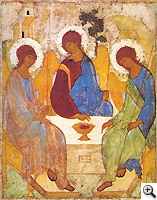 In Old Russia painting appeared and developed in a close connection with icon worshiping, the basis of which is the doctrine of Incarnation.
In Old Russia painting appeared and developed in a close connection with icon worshiping, the basis of which is the doctrine of Incarnation. Alongside with Christianity the Russian masters adopted the Byzantium artistic style and technique developed through centuries.
Henceforth in Russian principalities icon-painting schools having their own peculiarities of painting were formed (Novgorod, Pskov, Yaroslavl, Tver icon-painting schools).
The highest flourishing of Russian medieval painting refers to the 14th-15th centuries and it is reflected in the works of Pheophan Grek and Andrey Rublev. The top of Russian icon painting is “Trinity” (1422-1427) by A. Rublev, which he created as a symbol of spiritual consent and unity of Russian people.
Since the middle of the 16th century icon painting undergoes the influence of Western fine arts. Developed icon painting of the court school used Western European plot schemes.
The end of the 16th century and the beginning of the 17th century is marked by the development of 'Stroganoff school' (despite the name it consisted mainly of court masters) that is distinguished by the refinement of color and careful working at details and by the tendency to some decoration and 'prettiness' of painting.
In the second half of the 17th century icons included the elements of Western European painting: oil colors and great verisimilitude in depicting people and nature. The most prominent representative of the trend is Simon Ushakov. The first attempts of creating a temporal portrait can also be referred to that time.
Until the 18th century in Russia, the reigning artistic influence was still the Middle Ages Byzantium style. Even to this day, Russian icons, with their soulful eyes, flattened perspective, elongated features and gold highlights, remain characteristic in the region's artistic output.
But in 1701 Tsar Peter Alexeevich - Peter the Great - set the foundation of a new Russian capital in St.Petersburg, as well as the foundation for a new culture and art forms conceived in imitation of Western European. Under his rule, artists were sent abroad to study, and painters from Western Europe were brought to work in Russia. A drawing school was established, and then many Academies were established.
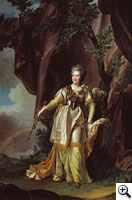 The prevailing painting genre through the 18th century was portraiture, based primarily on classical aesthetics. In the 18th century and at the beginning of the 19th century fine arts in Russia, following cultural needs of the society, experiences all the main stages of Western art: Baroque, Classicism, Romanticism. Foreign painters and sculptors, invited to Russia, play an important role but very talented home masters appear. The highest achievement of the epoch is portrait painting in the works by I. Argunov, А.Antropov, F Rokotov, D. Levitskiy, V. Borovikovskiy, O. Kiprenskiy. The first great Russian master of a sculpture portrait was F.Shubin. D.Levitskiy: Portrait of
The prevailing painting genre through the 18th century was portraiture, based primarily on classical aesthetics. In the 18th century and at the beginning of the 19th century fine arts in Russia, following cultural needs of the society, experiences all the main stages of Western art: Baroque, Classicism, Romanticism. Foreign painters and sculptors, invited to Russia, play an important role but very talented home masters appear. The highest achievement of the epoch is portrait painting in the works by I. Argunov, А.Antropov, F Rokotov, D. Levitskiy, V. Borovikovskiy, O. Kiprenskiy. The first great Russian master of a sculpture portrait was F.Shubin. D.Levitskiy: Portrait ofCatherine the Great
 The flourishing of an academic school refers to the first half of the 19th century. K. Brullov’s canvases are characterized by the combination of academic Classicism with Romanticism, by novelty of plots, by the theatrical effect of plastic and lighting, by complex composition and by brilliant virtuosity of a painter's brush. A. Ivanov added some character of sacrificial devotion to the idea and he managed to overcome lots of patterns referring to academic technique. At that time P.Fedotov followed his own way. He was considered to be a brilliant dilettante, a subtle observer and a witty satirist, who anticipated further trends of Russian genre-painting.
The flourishing of an academic school refers to the first half of the 19th century. K. Brullov’s canvases are characterized by the combination of academic Classicism with Romanticism, by novelty of plots, by the theatrical effect of plastic and lighting, by complex composition and by brilliant virtuosity of a painter's brush. A. Ivanov added some character of sacrificial devotion to the idea and he managed to overcome lots of patterns referring to academic technique. At that time P.Fedotov followed his own way. He was considered to be a brilliant dilettante, a subtle observer and a witty satirist, who anticipated further trends of Russian genre-painting. Social aspiration of 1860-1870s awakes the painters' interest in the themes connected with people's life. In 1872 in contrast to the Academy of Arts the Association of traveling art exhibition is founded (I. Kramskoy, G. Myasoedov, K. Savitskiy, I. Pryanishnikov, V. Makovskiy, I. Yaroshenko, V. Perov, etc). The Itinerants F.Vasilyev: Village (1869) (or The Peredvizhniks) became serious rivals to Academy-trained artists, and by 1870 had become the key force in Russian art. They emphasized realistic, socially concerned images of Russian life. Genre painting acquires some exposing character in their works.
 The appeal to national themes resulted in unprecedented flourishing of historical and battle painting. V. Surikov, I. Repin, N.Ghe, V. Vasnetsov, V. Vereschagin, F. Rubo created real masterpieces in those genres. The first Russian Art Galleries were opened during those years; the works of Russian painters were exhibited regularly in international exhibitions and foreign art salons.
The appeal to national themes resulted in unprecedented flourishing of historical and battle painting. V. Surikov, I. Repin, N.Ghe, V. Vasnetsov, V. Vereschagin, F. Rubo created real masterpieces in those genres. The first Russian Art Galleries were opened during those years; the works of Russian painters were exhibited regularly in international exhibitions and foreign art salons. I. Repin: Barge Haulers on the Volga
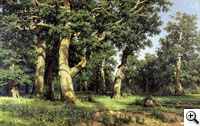 The end of the 19th century is also marked by awakening interest in an icon as 'a great world art' (E.Trubetskoy). It was possible thanks to clearing of ancient samples grown dark and discovering their real color. Artistic principles of icon painting were used creatively by both single Russian icon-painters (V. Vasnetsov, M. Nesterov, K. Petrov-Vodkin, foreign ones (A.Matisse) and by the whole trends and vanguard schools.
The end of the 19th century is also marked by awakening interest in an icon as 'a great world art' (E.Trubetskoy). It was possible thanks to clearing of ancient samples grown dark and discovering their real color. Artistic principles of icon painting were used creatively by both single Russian icon-painters (V. Vasnetsov, M. Nesterov, K. Petrov-Vodkin, foreign ones (A.Matisse) and by the whole trends and vanguard schools. Having achieved independence in their creative activity landscape painting is ousting genre painting. Since the end of the 19th century Russian painting follows the same European course of fine arts. Striving for depicting air and light, peculiar to Impressionism, can also be found in the I.Shishkin: Oak-wood (1887)
w
 orks of F. Vasilyev, I. Levitan, V. Serov, K. Korovin, A. Arkhipov, etc.
orks of F. Vasilyev, I. Levitan, V. Serov, K. Korovin, A. Arkhipov, etc.The 1910s are marked by the appearance of Russian vanguard, as an aspiration to rebuild the very essence of art up to the denial of art itself. A number of artists and creative associations set new schools and new trends, which influenced radically the development of world's fine arts - Supermatism (K. Malevich), 'the style of improvisation' and abstract art (V. Kandinskiy).
V.Kandinsky: Composition VIII
"Bytovoi zhhanr", the painting of everyday life, particularly depicting serfs in the country, remained influential through the Soviet years.
The Renaissance of Russian vanguard is referred to 1960s. So-called “allowed”, but not the official part of Russian art of the 1960s is represented by the works of the masters of “severe style” (T.Salakhov, S.Popkov). In 1970-1980s the works of Soviet painters (R.Bichuns, P.Tordia, D.Zhilinsky, E.Shteinberg, M.Romadin, M.Leis, V.Kalinin, etc.) were generally recognized. Those painters proved that there existed not only 'propaganda' in the USSR.
Crash of Communism in the USSR destroyed artificial cultural barriers between Russia and the rest of the world. Nowadays Russian art is a welcome visitor almost on every part of the world. This inspires optimism as cross-cultural communication is a real sign showing the state of world's art.
Vocabulary
the Itinerants (the Peredvizhniks/ the Wanderors) – передвижники - painters of Russian realistic school with democratic tendencies.
the very essence – сама суть
artistic perception - художественное восприятие
icon worshiping – преклонение перед иконописью
worship - культ; поклоняться, почитать
alongside with – наряду с
Byzantium - Византия
artistic technique –художественная техника
henceforth - с этого времени, впредь
to flourish - расцветать
a symbol of spiritual consent and unity – символ духовного согласия и единства
to undergo the influence of - подвергаться влиянию
temporal portrait – светский портрет
to conceive – зарождать, зачать, задумывать
to hold sway – иметь влияние
plot - фабула, сюжет
novelty of plot – новизна сюжета
gist – основное содержание рассказа
to be distinguished by - отличаться чем-либо
careful work at details – тщательная работа над деталями
the tendency to decoration and 'prettiness’ - тенденция к украшательству
verisimilitude - правдоподобие
representative of the trend - представитель направления
to be marked - быть отмеченным
to be characterized by - характеризоваться чем-либо
awakening interest in - пробуждающийся интерес к
the refinement of color - утонченность, изысканность чвета
academic manner - акдемическая манера
plastic – пластичный, гибкий
plastic art – искусство ваяния, скульптура
brilliant virtuosity - блестящая виртуозность, понимание тонкостей
sacrificial devotion to the idea – жертвенная преданность идее
to sacrifice - жертвовать
to shake the traditions of - потрясти традиции
dilettante - дилетант, любитель
a subtle observer - тонкийб (острый) наблюдатель
a witty satirist – остроумный сатирик
to anticipate - предчувствовать
to acquire - приобретать
exposing character – обличабщий характер
to result in – приводить к чему-либо
to exhibit - экспонировать
to oust - вытеснять
to strive for – стремиться к чему-либо
peculiar to – характерный для
to destroy artificial cultural barriers – разрушить искусственные культурные барьеры
Vanguard - авангард, авангардный
Baroque - барокко, барочный
Classicism - классицизм
Romanticism - романтизм
Task 19. Chose the answer (a, b, c) which you think fits best according to the text
1. In Old Russia painting appeared and developed in a close connection with
a) portrait painting
b) icon worshiping
c) intensive study of the human body
2. The highest flourishing of Russian medieval painting refers to
a) the 14th-15th centuries
b) the 10th-11th centuries
c) the 12th-13th centuries
3. The end of the 16th century and the beginning of the 17th century is marked by the development of
a) Leonardo’s school
b) Rublev’s school
c) Stroganoff ‘s school
4. The highest achievement of the 18th century is
a) historical painting
b) landscape painting
c) portrait painting
5. K Brullov’s canvases are characterized by the combination of
a) careful working at details and by the tendency to some decoration
b) academic Classicism with Romanticism
c) independence in his creative activity and classical aesthetics
6. The traveling art exhibition was founded in
a) 1782
b) 1872
c) 1987
7. Social aspiration of 1860-1870s awakes the painters' interest in the themes connected with
a) people's life
b) nature life
c) Middle Ages Byzantium style
8. Since the end of the 19th century Russian painting follows
a) unique Russian course of fine arts
b) Renaissance style
c) the same European course of fine arts
9. The influence of Imporessionism can be found in the works by
a) A. Vrubel
b) V. Kandinskiy
c) I. Levitan and K. Korovin
10. K Malevich is considered to be a representative of the trend, called
a) Supermatism
b) Symbolism
c) Abstract art
Task 20. Translate froм Russian into English.
- В истории русского искусства различают два периода
- Русская живопись развивалась в тесной связи преклонением перед иконописью.
- Наивысший расцвет русской средневековой живописи относится к 14-15 векам.
- Вершиной русской иконной живописи является картина А.Рублева «Троица».
- С середины 16 века русская иконная живопись находится под влиянием западного искусства.
- Строгановская школа отличается изысканностью цвета, тщательной отработкой деталей и тенденцией к украшательству.
- Восточная европейская живопись этого периода уделяет большое внимание сходству в изображении людей и животных.
- В 1701 году русский царь Петр Великий заложил основы новых форм искусства , основанные на имитации искусства Западной Европы.
- В 18 вере превалирующим жанром в живописи был классический портрет.
- Для русских икон характерна плоская перспектива, удлиненные черты, глаза, раскрывающие душу, и золотые блики.
- Передвижники стали серьезными соперниками художников, представляющих академическое искусство.
- Представители направления передвижников особое внимание уделяли реалистичности изображения и социальной значимости объектов.
- Полотна К. Брюллова характеризуются сочетанием академического классицизма с романтизмом, новизной сюжета, световыми эффектами, сложной композицией и блестящей виртуозностью кисти художника.
- Хотя П. Федотов и считался блестящим дилетантом в живописи, он был тонким наблюдателем, остроумным сатириком, предвосхитившим дальнейшие тенденции русской жанровой живописи.
- В 1872 году было основано общество передвижников. В их работах жанровая живопись приобретает обличающий характер.
- В конце 19 века пейзажная живопись вытесняет жанровую живопись.
- Русское искусство идет в том же направлении, что и современное европейское искусство.
- Ренессанс русского авангарда относится к 60- ым годам 20 века, а работы советских авангардистов были признаны во всем мире.
- Крушение коммунизма в Советском Союзе разрушило культурные барьеры между Россией и остальным миром.
- Межкультурная коммуникация - это важный индикатор состояния мирового искусства.
Task 21. Translate into Russian in writing.
Until the 18th century in Russia, the reigning artistic influence was still the Middle Ages Byzantium style. Even to this day, Russian icons, with their soulful eyes, flattened perspective, elongated features and gold highlights, remain characteristic in the region's artistic output. But in 1701 Tsar Peter Alexeevich - Peter the Great - set the foundation of a new Russian capital in St.Petersburg, as well as the foundation for a new culture and art forms conceived in imitation of Western European. Under his rule, artists were sent abroad to study, and painters from Western Europe were brought to work in Russia. A drawing school was established, and then many Academies were established.
Task 22. Read this text and tell your friends about Russian folk ссылка скрыта.
Zhostovo painting
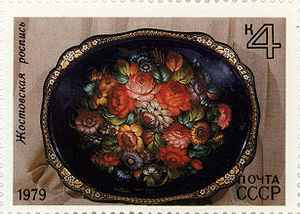 Zhostovo painting (Жостовская роспись) is an old ссылка скрыта folk ссылка скрыта of painting on ссылка скрыта trays, which still exists in a village of Zhostovo in the ссылка скрыта. It appeared in the early 19th century mainly under the influence of the ссылка скрыта handicraft of flower painting on metal. Subsequent development of the Zhostovo painting handicraft was stylistically related to ссылка скрыта and ссылка скрыта painting techniques, used by factories near ссылка скрыта, flower motifs on ссылка скрыта, produced by the ссылка скрыта factories, and ссылка скрыта (see ссылка скрыта).
Zhostovo painting (Жостовская роспись) is an old ссылка скрыта folk ссылка скрыта of painting on ссылка скрыта trays, which still exists in a village of Zhostovo in the ссылка скрыта. It appeared in the early 19th century mainly under the influence of the ссылка скрыта handicraft of flower painting on metal. Subsequent development of the Zhostovo painting handicraft was stylistically related to ссылка скрыта and ссылка скрыта painting techniques, used by factories near ссылка скрыта, flower motifs on ссылка скрыта, produced by the ссылка скрыта factories, and ссылка скрыта (see ссылка скрыта). Zhostovo painting is a handicraft of painting on metal trays, preliminary coated with a few layers of ссылка скрыта (ссылка скрыта) and oil ссылка скрыта (usually, black). Painting is done in a few consecutive energetic and firm strokes with a soft ссылка скрыта and ссылка скрыта, richly diluted with ссылка скрыта. The most widely used motif of the Zhostovo painting is a bunch of mixed garden and wild flowers, which is simple and laconic in its essence. The edges of a tray are painted with a light golden ornament called уборка (uborka). A finished tray is then covered with three layers of light ссылка скрыта and polished to brilliance.
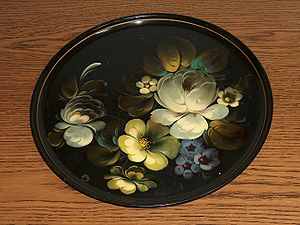 In the late 19th - early 20th century, the Zhostovo painting handicraft fell into decline. During the ссылка скрыта times, it was brought back to life after a number of ссылка скрыта had united themselves into one called Металлоподнос (Metal Tray) in 1928. Today, it is called the Zhostovo Factory of Decorative Painting (Жостовская фабрика декоративной росписи).
In the late 19th - early 20th century, the Zhostovo painting handicraft fell into decline. During the ссылка скрыта times, it was brought back to life after a number of ссылка скрыта had united themselves into one called Металлоподнос (Metal Tray) in 1928. Today, it is called the Zhostovo Factory of Decorative Painting (Жостовская фабрика декоративной росписи).(retrieved from "ссылка скрыта")
